Colossal Fossil
Air Date: Week of November 14, 2008
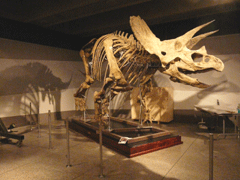
Cliff the Triceratops in his new home. (Photo: Bruce Gellerman)
After 65 million years, Cliff the Triceratops makes his world debut at Boston’s Museum of Science. Bruce Gellerman reports.
Transcript
[DINOSAUR ROAR]
GELLERMAN: In the entrance to Boston’s Museum of Science is a giant wood shipping container stenciled on the side “Air freight: Paris, France.” The box is wrapped in metal chains. A sign challenges museum-goers to guess what’s locked in the crate. From inside the box…a hint…a low rumbling roar…
[DINOSAUR ROAR]
GELLERMAN: 15,000 people submitted guesses. This week, after months of anticipation Boston’s Museum of Science finally took the wraps off, publicly unveiling its newest exhibit: a colossal fossil…a dinosaur skeleton.
Project Director Lynn Baum says it was donated by an anonymous benefactor who bought it at auction in Paris.
BAUM: We’re calling him Cliff because the person who bought the triceratops at the Christie's auction gets the right to name it, and he named it after his grandfather, so it’s Triceratops Cliff.
GELLERMAN: The bones of Cliff the Triceratops were found in 2004 in North Dakota, dug up, shipped to Paris, and, last year, auctioned off for nearly a million dollars. The buyer was from Boston and decided to lend it to the museum for seven years. The day Lynn Baum introduced me to Cliff, workers were putting the finishing touches on him, and he was getting some major dental work done.
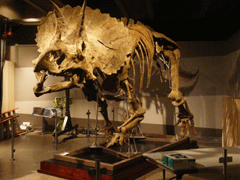
Cliff the Triceratops. (Photo: Bruce Gellerman)
How do you put a jawbone into a triceratops?
BAUM: Carefully, very carefully - because it is 65 million years old.
GELLERMAN: Triceratops roamed North and South Dakota and other western states and Canada during what’s called the late Cretaceous period. They were among the last dinosaurs on earth. Now 65 million years later, the job of putting the thousands of pieces of Cliff’s skeleton back together fell to the museum’s technical director, Kevin McEleney.
MCELENEY: Pretty much we assemble everything and anything...
GELLERMAN: What's the challenge of creating something like this - or recreating something like this?
MCELENEY: Um, trying to figure out how it went together in the first place. We don’t really have a manual to go by, and it’s trying to figure out which part goes where.
GELLERMAN: You didn't have any oops moment, did you?
MCELENEY: No..no oopses.
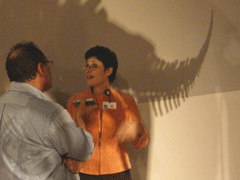
Gellerman interviews Lynn Baum (Photo: Jessie Martin)
GELLERMAN: Triceratops were enormous animals. With his distinctive three horns and mighty frill on his skull, Cliff’s head alone weighs 800 pounds. From nose horn to the tip of his tail, he’s 23 feet long.
Lynn Baum says when it came to completing Cliff’s skeleton, only a relatively small number of bones had to be made or substituted.
BAUM: It’s the fifth bone from the end….if you look at that, it’s a hydrosaur bone, not a triceratops bone.
GELLERMAN: So how much of this skeleton is real bone and real triceratops?
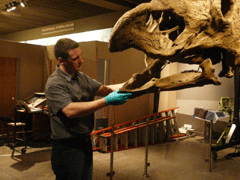
Putting Cliff back together again. (Photo: Jessie Martin)
BAUM: Well, we’re hesitant to give an exact percentage because it gets tricky, because, a lot may even be fractured pieces that have been put together with resin…but it’s well over half, there's well over 50 percent, which makes it one of the top five, six triceratops in the world, which is that complete. There are very, very few nearly complete skeletons - there are no totally complete skeletons.
GELLERMAN: So this is one of the best.
BAUM: This is one of the best … and that’s what’s so exciting about it.
[DINOSAUR ROAR]
GELLERMAN: Alive, Cliff the Triceratops must have been something to behold. Scientists suspect his giant head frill was used to attract members of the opposite sex and fend off attacks from his fiendish nemesis and neighbor, Tyrannosaurus Rex.
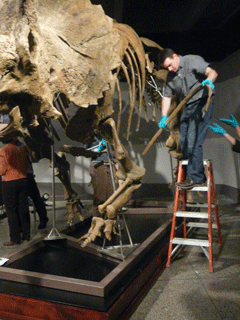
(Photo: Jessie Martin)
GELLERMAN: An herbivore…He didn’t eat meat?
BAUM: Well, think rhinoceros. Very heavily - you know, sturdy, very fierce, herbivores. So you don't want to mess with them, because they were very powerful, but they would have eaten ancient palms, their teeth were designed to actually snip palms like scissors, and if you look at the teeth you can see that they just meet up and down, the top and the bottom…and they had quite a few teeth in their mouth. And they were always shedding teeth, so they were always replacing teeth, sort of like sharks.
GELLERMAN: We know a lot about what triceratops ate and how and where they lived, from paleontologists who study what’s called coprolite.
HOGANSON: We do find a lot of coprolites in North Dakota. I’m not one of those paleontologists who study coprolites but coprolites, as you know, are fossil feces, or fossil turds.

Cliff the Triceratops in his new home. (Photo: Bruce Gellerman)
GELLERMAN: John Hoganson is State Paleontologist of North Dakota. He's in Boston for the opening of the Cliff the Triceratops exhibit. From coprolite, scientists have deduced that the dinosaur-bone-rich Hell Creek formation where Cliff was discovered was once a semi-tropical, hot and humid plain, far warmer than today. The geological record dramatically tells the story. The layer of rock where Cliff was found marks the end of the dinosaur era. Cliff and his kind were victims of cataclysmic climate change, caused when an astroid smashed near the Yucatan peninsula. From coprolite and the evidence in the stratified rocks, we know a lot of life 65 million years ago. But what’s really remarkable, is how little North Dakota State Paleontologist John Hoganson knows about Cliff the Triceratops today.
HOGANSON: Well, Cliff I believe was found in 2004, in southwestern North Dakota, and that’s about all I know. I don’t know who collected the fossil - the next thing I knew it ended up in auction in Paris.
GELLERMAN: But didn’t they have to get a license to dig in the state?
HOGANSON: In North Dakota, like all states in the Union, fossils found on private property belong to the landowner. So the state of North Dakota does not have jurisdiction over fossils found on private lands. We do have jurisdiction over fossils found on the public lands, like state lands or federal lands. So no, we don’t have any regulations that would allow us to ask for information from these commercial fossil collectors as to where they find these fossils.
GELLERMAN: So when you found out that Cliff was being auctioned off in Paris, and it was collected on private land in North Dakota, what was your thought?
HOGANSON: Well as a state paleontologist, and as the paleontologist that's been there for 28 years, these kinds of fossils do disturb us, because we don't know where they're found. Often times they leave the state, so we worry about these fossils ending up in private hands, and therefore not available for education or study.
GELLERMAN: John Hoganson says North Dakota lawmakers are now trying to change state law so private fossil finders will have to report their discoveries. And while he’d like Cliff to one day return home, Hoganson is pleased Cliff’s anonymous owner decided to display the Triceratops skeleton at the Boston Museum of Science.
HOGANSON: I just saw Cliff for the first time a few minutes ago, and they’ve done such a wonderful job here. They’ve got the skeleton postured so it gives the animal some animation to it - It’s nicely done. So we’re very happy this fossil from North Dakota ended up in the Museum of Science for display and study.
[DINOSAUR ROAR]
Links
Living on Earth wants to hear from you!
Living on Earth
62 Calef Highway, Suite 212
Lee, NH 03861
Telephone: 617-287-4121
E-mail: comments@loe.org
Newsletter [Click here]
Donate to Living on Earth!
Living on Earth is an independent media program and relies entirely on contributions from listeners and institutions supporting public service. Please donate now to preserve an independent environmental voice.
NewsletterLiving on Earth offers a weekly delivery of the show's rundown to your mailbox. Sign up for our newsletter today!
 Sailors For The Sea: Be the change you want to sea.
Sailors For The Sea: Be the change you want to sea.
 The Grantham Foundation for the Protection of the Environment: Committed to protecting and improving the health of the global environment.
The Grantham Foundation for the Protection of the Environment: Committed to protecting and improving the health of the global environment.
 Contribute to Living on Earth and receive, as our gift to you, an archival print of one of Mark Seth Lender's extraordinary wildlife photographs. Follow the link to see Mark's current collection of photographs.
Contribute to Living on Earth and receive, as our gift to you, an archival print of one of Mark Seth Lender's extraordinary wildlife photographs. Follow the link to see Mark's current collection of photographs.
 Buy a signed copy of Mark Seth Lender's book Smeagull the Seagull & support Living on Earth
Buy a signed copy of Mark Seth Lender's book Smeagull the Seagull & support Living on Earth

